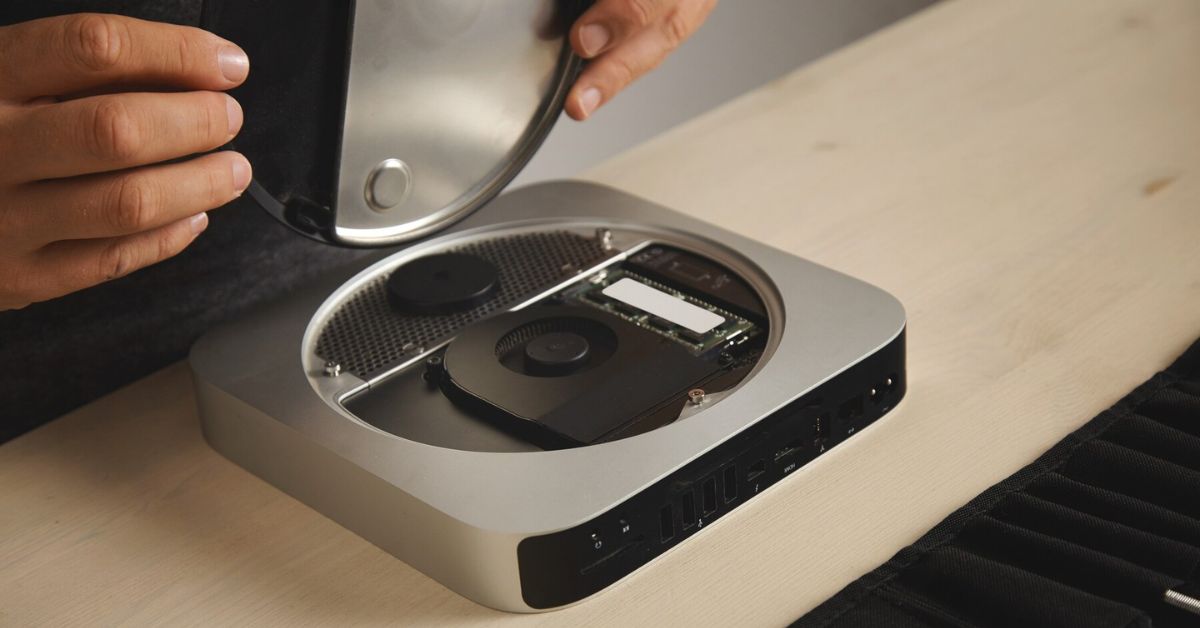TECHNOLOGY
How to Add a Disk to OpenMediaVault: What you need to know

If you’re running out of space on your how to add a disk to openmsedia valt (OMV) server or need to expand your storage for more files, adding a new disk to OMV is a great solution. This guide will take you through each step, from connecting your hardware to configuring OMV to use the new disk.
What is OpenMediaVault?
OpenMediaVault (OMV) is a powerful, Debian-based NAS (Network-Attached Storage) solution. With OMV, users can manage and share their files across their network easily. OMV is perfect for home users or small businesses looking for a cost-effective way to handle data storage.
Why Add a Disk to OpenMediaVault?
Adding a new disk to OMV brings numerous benefits:
Extra storage capacity: Store more files and media.
Improved data organization: Separate files across different drives.
Data redundancy: Use additional disks for data backup or RAID.
Prerequisites for Adding a Disk to OMV
Before you begin, ensure you have the necessary hardware, such as a compatible hard drive or SSD. It’s also wise to back up any existing data to prevent accidental loss.
OpenMediaVault supports a variety of disk types, from HDDs to SSDs, connected via SATA or USB. Before using the disk in OMV, ensure it’s properly formatted and free of important data.
MUST READ: How to Access MyBookCave.com: A Step-by-Step Guide
Connecting the Disk Physically
Depending on the type of disk, connect it to your OMV server through a SATA port, USB, or other available interfaces. Make sure all cables are securely connected to prevent data issues.
Log in to how to add a disk to openmsedia valt web interface by entering your server’s IP address in a browser. Use your credentials to access the dashboard, where you can manage storage settings.
Detecting the New Disk in OMV
In OMV’s dashboard, go to Storage > Disks to locate the newly connected disk. OMV will scan for hardware and list any unrecognized disks.
OMV requires the disk to be formatted before use. Choose EXT4 or another suitable file system under Storage > File Systems. Click “Create,” select the new disk, and proceed with formatting.
Mounting the Disk in OMV
After formatting, mount the disk to make it accessible. In Storage > File Systems, select the new disk and click “Mount.” This step enables OMV to use the disk for storage.
With the disk mounted, go to Access Rights Management > Shared Folders. Create a new shared folder on the disk and assign it a name. This folder will be accessible over the network.
Setting Up User Permissions
Control who can access the new shared folder by managing user permissions. Go to Access Rights Management > Users and configure access based on each user’s needs.
OMV supports various services like SMB (Windows file sharing) and NFS (Linux/Unix sharing). Enable the required service under Services to allow network access to the new disk.
Testing Access to the New Disk
Once configured, test access to ensure everything works. Access the shared folder from another device on your network to verify that you can read and write to the disk.
If you encounter issues, ensure the disk is properly connected and formatted. Restarting OMV or re-checking permissions can often resolve minor problems.
Conclusion
Adding a new disk to how to add a disk to openmsedia valt is a straightforward way to increase your storage and improve data management. With this guide, you should be able to add a new disk confidently and start using it for your storage needs.
FAQs
Can I add multiple disks to OpenMediaVault?
Yes, OMV allows you to add multiple disks, which you can manage individually or set up in a RAID configuration.
What file system should I use on my OMV disk?
EXT4 is the most recommended file system for OMV due to its compatibility and reliability, but others like BTRFS are also supported.
Is it possible to remove a disk after adding it to OMV?
Yes, you can unmount and safely remove a disk. However, ensure all data is backed up if needed before removing it.
Does OMV support SSDs?
Absolutely! OMV works well with both HDDs and SSDs, and adding an SSD can improve read/write speeds.
READ MORE: CLICK HERE
TECHNOLOGY
AppForDown Android: The Ultimate Guide to Downloading Android Apps Safely

Are you an Android user looking for an easy and safe way to download apps? If so, you may have come across the term “AppForDown Android.” This platform is gaining popularity, but what exactly is it, and how does it work? In this article, we’ll dive deep into everything you need to know about AppForDown Android, including its features, benefits, and how to use it for a smooth and secure app downloading experience.
What is AppForDown Android?
AppForDown Android is an online platform that allows users to download Android apps and games without the restrictions imposed by traditional app stores like Google Play. It serves as an alternative marketplace for apps, offering a wide range of free and premium content.
The platform provides users with a collection of APK files (Android application packages), enabling direct downloads of apps and games. It is particularly useful for those who want to explore apps not available on the Play Store or for users in regions where certain apps are restricted.
MUST READ: Everything You Need to Know About ZVideo: The Ultimate Guide
How Does AppForDown Android Work?
AppForDown works by hosting APK files on its website, allowing users to download them directly to their devices. This process bypasses the need for traditional app store systems. It’s important to note that the platform itself is not an app but a website where users can search for APKs and download them with ease.
Step-by-Step Guide to Downloading from AppForDown
- Visit the Website: To start, simply go to the AppForDown website. It’s accessible via any browser on your Android device.
- Search for Your Desired App: Use the search bar or browse through the categories to find the app or game you’re looking for.
- Choose the Version: Depending on the app, there may be multiple versions available. Select the one compatible with your Android version.
- Download the APK: Hit the download button to save the APK file to your device.
- Install the APK: Once downloaded, locate the file and tap on it to begin the installation. You may need to enable installation from unknown sources in your device settings.
- Enjoy the App: After installation, you can start using the app right away.
Is It Safe to Use AppForDown Android?
One of the most common concerns about downloading apps from third-party sources is safety. While AppForDown does not directly distribute harmful apps, it’s essential to take precautions before downloading anything.
How to Ensure Safe Downloads
- Use Antivirus Software: Install a reputable antivirus app on your device to scan APK files before installation.
- Check App Permissions: Always review the permissions requested by an app before installing it. If an app asks for unnecessary access, avoid installing it.
- Read User Reviews: Look for user feedback about the APK version you’re downloading. This can help you gauge whether it’s safe or reliable.
- Keep Your Device Updated: Regularly update your Android system to protect it from security vulnerabilities.
By following these guidelines, you can reduce the risk of downloading malicious software from third-party sites like AppForDown.
The Benefits of Using AppForDown Android
There are several advantages to using AppForDown for Android app downloads. Here’s a breakdown of some key benefits:
1. Access to Restricted Apps
One of the biggest reasons Android users turn to AppForDown is access to apps that may not be available in their region or on the Play Store. For example, certain apps may be restricted by geographic location, and AppForDown provides a way to bypass these limitations.
2. No Google Play Store Limitations
The Google Play Store often imposes restrictions on certain apps, such as size limits, app categories, or content guidelines. With AppForDown, you can bypass these restrictions and download apps that may not pass Play Store’s stringent policies.
3. Older Versions of Apps
If you prefer using an older version of an app for compatibility reasons or simply because you like it better, AppForDown makes it easy to find APKs of older app versions. This feature is a real lifesaver for users who don’t want to deal with the latest updates.
4. Free Access to Paid Apps
Sometimes, AppForDown offers access to paid apps for free, although this might not always be the case. This can save you money, especially if you’re looking for high-quality apps or games without the price tag.
5. User-Friendly Interface
The website is designed to be simple and easy to navigate. You don’t need technical knowledge to download apps from AppForDown, making it ideal for casual users.
Potential Risks of Using AppForDown Android
While there are many benefits, it’s also important to be aware of the potential risks. Using third-party app download platforms like AppForDown may expose you to:
1. Malware and Viruses
APK files from untrusted sources may contain malware, which can harm your device or steal personal information. This is why it’s crucial to be vigilant when downloading APKs.
2. Lack of Updates
Apps downloaded from AppForDown might not receive updates as quickly as those from official app stores, leaving your apps outdated and potentially insecure.
3. Compatibility Issues
Some apps on AppForDown may not be optimized for your specific Android version, leading to performance issues or crashes.
4. Violation of Terms of Service
Downloading apps from third-party sources may violate the terms of service of certain apps or games. This could lead to your account being banned or other issues.
How to Avoid Common Pitfalls When Using AppForDown
To avoid the risks associated with third-party app downloads, follow these simple tips:
1. Always Check the Source
Only download APKs from trusted sources like AppForDown. Avoid downloading apps from random websites to reduce the risk of malware.
2. Use Reliable Antivirus Software
Having antivirus software on your device is essential for protecting your device from harmful apps and viruses. Scan all APKs before installing them.
3. Stay Informed About App Updates
Make sure to check for updates on official app stores, even if you’ve downloaded the app from AppForDown. This will ensure you stay up-to-date with the latest features and security patches.
Alternative Ways to Download Android Apps Safely
If you’re still cautious about using AppForDown, there are other alternatives for downloading Android apps safely. Consider the following options:
1. Aptoide
Aptoide is another popular alternative to Google Play. It offers a wide range of apps and is known for its user-friendly interface and community-driven marketplace.
2. APKMirror
APKMirror is a trusted site that provides APKs for Android apps. The site is known for verifying apps before they’re made available for download, making it a safer choice for users.
3. F-Droid
F-Droid is an open-source app store that focuses on free and open-source software for Android. It’s a great choice for privacy-conscious users.
Conclusion
AppForDown Android is an excellent platform for downloading Android apps, especially when you need access to apps that aren’t available in your region or on the official Google Play Store. However, as with any third-party source, it’s essential to be cautious and use proper safety measures to avoid downloading harmful apps. By following the guidelines mentioned in this article, you can make the most of AppForDown while ensuring your device remains secure.
FAQs
1. Is AppForDown Android legal to use?
Yes, using AppForDown is legal, but downloading copyrighted apps for free may violate intellectual property laws, so it’s important to be cautious about what you download.
2. Can I download paid apps for free from AppForDown?
Some paid apps may be available for free, but this is not guaranteed. Always check the app’s legitimacy before downloading.
3. Is it safe to download APKs from AppForDown?
While AppForDown itself is not a harmful site, the APKs you download could be unsafe. Always use antivirus software and be cautious when downloading apps.
4. How can I ensure an app is safe before downloading it from AppForDown?
Check user reviews, verify the APK’s source, and use antivirus software to scan the file before installing it.
5. Can I update apps downloaded from AppForDown?
You may need to manually check for updates, as apps from third-party platforms do not automatically update like those from official stores.
TECHNOLOGY
Introduction to Proxiyum A Comprehensive Guide

In today’s fast-paced digital world, maintaining security, privacy, and efficient operations is more critical than ever. This is where Proxiyum comes in—a powerful tool that offers businesses and individuals an edge in navigating the complexities of the digital landscape. But what exactly is Proxiyum, and why should you care? Let’s dive into its features, benefits, and how it can help you thrive in an increasingly digital world.
What is Proxiyum?
Proxiyum is an innovative solution designed to enhance data security, improve digital workflows, and provide a seamless experience for users. While its primary focus is on cybersecurity and data privacy, Proxiyum also plays a vital role in streamlining business operations. Essentially, Proxiyums acts as a powerful tool that protects and manages data while offering an extra layer of security for digital activities.
Whether you’re a business owner or an individual looking to enhance your privacy, Proxiyums offers a wide array of features to help safeguard sensitive information and ensure that your digital activities remain secure.
Proxiyum in the Digital Age
The digital age has brought numerous advancements, but it has also introduced risks such as data breaches, identity theft, and cyber attacks. Proxiyums plays a critical role in combating these risks by offering a secure environment where users can protect their personal and business-related data.
As businesses and individuals become more reliant on the internet and digital platforms, the importance of tools like Proxiyums cannot be overstated. It works behind the scenes to keep personal information safe, ensuring that privacy is maintained while interacting online.
MUST READ: Explore m0therearf: A Unique Autonomous Digital Ecosystem
Key Features of Proxiyum
What makes Proxiyums stand out in a crowded field of cybersecurity tools? Here are some of its most important features:
- Advanced Encryption: Proxiyums uses cutting-edge encryption algorithms to protect data, ensuring that it remains safe during transmission and storage.
- User-Friendly Interface: Unlike many complex cybersecurity tools, Proxiyums is designed to be easy to use, making it accessible to both tech-savvy individuals and beginners.
- Multi-Layer Security: Proxiyums employs multiple security measures, including firewalls, secure VPN connections, and real-time monitoring, to detect and prevent potential threats.
- Seamless Integration: It integrates effortlessly with a variety of platforms, applications, and devices, making it a versatile choice for individuals and businesses alike.
- Data Privacy Compliance: Proxiyum adheres to global data privacy regulations, such as GDPR, ensuring that users’ sensitive information is handled in compliance with the law.
Proxiyum’s Impact on Business Operations
Businesses are often the prime targets for cyber threats, making it crucial for organizations to implement robust security measures. Proxiyum helps businesses safeguard not only sensitive customer data but also internal communications, financial information, and intellectual property.
By integrating Proxiyum into business operations, companies can streamline their workflows while ensuring that their data remains protected. The tool helps businesses mitigate risks associated with data breaches, which can lead to significant financial losses and reputational damage.
Proxiyum’s Impact on Cybersecurity
When it comes to cybersecurity, Proxiyum goes beyond basic protection. It is a proactive security solution designed to anticipate and address potential vulnerabilities before they can be exploited. With the rise of sophisticated cyber-attacks, it’s no longer enough to rely on traditional security measures.
Proxiyum’s multi-layered approach ensures that businesses and individuals are protected from a wide variety of cyber threats, including malware, ransomware, and phishing attacks.
The Role of Proxiyums in Data Privacy
Proxiyum is also a valuable tool when it comes to data privacy. With the increasing number of privacy laws and regulations around the world, it can be challenging for businesses and individuals to stay compliant. Proxiyum ensures that all personal data is encrypted and stored securely, reducing the risk of unauthorized access.
Proxiyums also enables businesses to manage user consent, track data access, and ensure that personal information is only shared with authorized parties. This level of control is crucial in maintaining the trust of customers and avoiding costly fines.
Benefits of Using Proxiyums for Individuals
For individuals, Proxiyum offers several key benefits that enhance digital security and privacy:
- Secure Online Transactions: Whether you’re shopping online, banking, or making investments, Proxiyum ensures that your financial information is encrypted and protected.
- Identity Protection: Proxiyum helps protect your personal identity by preventing unauthorized access to sensitive data such as social security numbers, credit card details, and passwords.
- Online Anonymity: Proxiyum provides a secure browsing environment, allowing users to surf the web anonymously and access content without leaving a digital footprint.
Is Proxiyums Right for You?
So, is Proxiyum right for you? If you value your privacy and digital security, the answer is a resounding yes! It’s particularly beneficial for:
- Small businesses looking to protect their client data and business information.
- Frequent travelers who need a reliable way to protect their data on public Wi-Fi networks.
- Individuals who want to ensure their personal information stays safe online.
Before committing to Proxiyum, however, it’s important to evaluate your specific needs and determine whether the tool aligns with your privacy and security goals.
How to Get Started with Proxiyum
Getting started with Proxiyum is simple. Here’s a step-by-step guide to help you:
- Sign Up for Proxiyums: Visit the official website and create an account. Choose the plan that best fits your needs, whether for personal or business use.
- Download the Application: After signing up, download the Proxiyum application to your device or server. It’s compatible with most major platforms.
- Configure Security Settings: Set up your security preferences, including encryption settings, privacy filters, and access controls.
- Monitor and Manage: Once everything is set up, use Proxiyum’s dashboard to monitor your security status, check for vulnerabilities, and make adjustments as needed.
Proxiyum vs. Competitors
There are numerous cybersecurity solutions available, so how does Proxiyum stack up against the competition? When compared to other tools, Proxiyum stands out for its ease of use, robust security features, and excellent customer support. Many competing solutions are either too complex for everyday users or lack the necessary features to provide comprehensive protection.
What makes Proxiyum unique is its combination of advanced technology with a user-friendly interface, making it an attractive choice for both beginners and experienced users.
Common Mistakes to Avoid When Using Proxiyum
While Proxiyum is easy to use, some users make common mistakes that can reduce its effectiveness:
- Neglecting Regular Updates: Make sure to regularly update your Proxiyum software to benefit from the latest security patches.
- Weak Passwords: Always use strong, unique passwords to protect your Proxiyum account and data.
- Ignoring Privacy Settings: Don’t skip configuring the privacy settings. Customize them according to your needs to maximize data protection.
The Future of Proxiyum
As digital threats evolve, Proxiyums continues to innovate. The future of Proxiyum is focused on expanding its capabilities to handle new types of cyber threats, such as AI-driven attacks and blockchain vulnerabilities. With the rise of digital transformation, Proxiyum is likely to become an even more integral part of cybersecurity strategies for businesses and individuals alike.
Proxiyum’s Role in Innovation
Proxiyums is also at the forefront of technological innovation, contributing to the development of new digital privacy solutions. As more people and businesses adopt digital technologies, Proxiyum will continue to evolve, ensuring that digital security and privacy are accessible to all.
Conclusion
In conclusion, Proxiyums offers a comprehensive solution for enhancing digital security, protecting privacy, and streamlining business operations. Whether you’re an individual looking to safeguard your online presence or a business aiming to protect sensitive data, Proxiyum provides the tools and features necessary to meet today’s cybersecurity challenges. Its ease of use, robust security features, and forward-thinking approach make it a standout choice in a crowded market.
FAQs about Proxiyum
What makes Proxiyums different from other cybersecurity tools?
Proxiyum combines ease of use with advanced security features, making it ideal for both individuals and businesses.
Can I use Proxiyums on multiple devices?
Yes, Proxiyum is compatible with a variety of devices, including smartphones, tablets, and computers.
Is Proxiyums suitable for small businesses?
Absolutely! Proxiyum offers tailored solutions to help small businesses protect their data and enhance security.
How does Proxiyums protect my personal information?
Proxiyums uses encryption and secure protocols to protect your personal data from unauthorized access.
Does Proxiyums offer customer support?
Yes, Proxiyums provides excellent customer support through various channels, including email and live chat.
READ MORE: CLICK HERE
TECHNOLOGY
ETSIOSAPP Release Date: What We Can Expect from the Upcoming Launch

The world of mobile applications is constantly evolving, with developers working tirelessly to bring fresh innovations that improve the way we live, work, and interact. One of the most anticipated app releases of the year is ETSIOSAPP. This app has generated a lot of buzz in recent months, with users eagerly waiting for its official launch. But when will it finally be available for download? And what makes ETSIOSAPP so special? In this article, we’ll explore everything we know so far about the ETSIOSAPP release date, its features, and what to expect once it hits the app stores.
What is ETSIOSAPP?
ETSIOSAPP is a cutting-edge application designed to revolutionize its specific niche, offering users a seamless experience with powerful functionalities. But before diving into the specifics, let’s take a step back and understand what ETSIOSAPP is all about.
Overview of ETSIOSAPP
ETSIOSAPP is an innovative app that blends advanced technology with user-friendly features. Whether it’s a game-changing productivity tool, a social media platform, or an app that addresses a unique gap in the market, ETSIOSAPP promises to deliver high-quality performance and a smooth user experience.
Purpose and Features of the App
The app’s main purpose is to solve specific issues faced by users in its targeted market. With a combination of advanced features like AI integration, real-time data syncing, or a one-of-a-kind UI, ETSIOSAPP is built to make a difference. The app aims to offer cutting-edge technology wrapped in an intuitive design, making it accessible for all users regardless of their tech expertise.
MUST READ: AMA77K: A Comprehensive Look at a Groundbreaking Technology
The Importance of ETSIOSAPP in Today’s Digital Ecosystem
In an ever-changing digital landscape, the arrival of a new app like ETSIOSAPP can stir excitement among both consumers and industry experts. But why exactly is ETSIOSAPP being talked about so much?
Solving Current Issues in the Market
One of the standout factors that have contributed to the growing anticipation around ETSIOSAPP is its ability to address pressing issues that existing apps don’t fully cover. By filling these gaps, ETSIOSAPP is expected to become a valuable tool for users across various fields, making life easier, more efficient, and more enjoyable.
How It Stands Out from Competitors
With its combination of unique features, modern technology, and strong user experience focus, ETSIOSAPP has already distinguished itself from competitors in the market. While other apps may offer similar functionalities, ETSIOSAPP adds a distinctive touch that could redefine how users approach certain tasks or activities.
ETSIOSAPP Release Date: What We Know So Far
Now, let’s get to the most crucial part—when will ETSIOSAPP finally be available?
Speculated Release Date
While the developers behind ETSIOSAPP have not officially confirmed a specific release date, rumors and leaks suggest that the app could be launched within the next few months. The anticipation has been building as speculation runs wild, and fans have been analyzing every update from the development team for clues.
Official Announcements
So far, the developers have only hinted at a release window without giving a definitive date. However, they’ve promised that the app will be worth the wait. Keep an eye on official announcements for updates on the exact date.
Why the Delay?
Many users have been eagerly awaiting the launch of ETSIOSAPP, but delays are not uncommon in the app development world. Here are some reasons behind the pushback in the release date:
Technical Challenges Behind the Delay
Developing an app as complex and feature-rich as ETSIOSAPP can come with several technical hurdles. Ensuring that all features work seamlessly, fixing bugs, and optimizing the app for different devices and operating systems are just a few of the challenges that might contribute to delays.
Developer Insights
According to the development team, the delay is mainly due to ensuring the app’s performance is up to the standards that users expect. They are working hard to refine the app’s user interface, ensure security measures are in place, and address any compatibility issues to provide a flawless experience.
Where Will ETSIOSAPP Be Available?
Another exciting part of the launch is determining where users can access the app. Will it be limited to certain regions or available worldwide?
Platforms for Launch (iOS, Android, etc.)
ETSIOSAPP will likely be released on multiple platforms to reach the broadest audience possible. Expect to see it on both iOS and Android devices, so whether you have an iPhone or an Android smartphone, you will be able to download and enjoy the app.
Global Availability
The app will most likely be launched globally, but there could be some initial regional restrictions based on the app’s complexity, localized content, or marketing strategy. Users in certain regions might get early access through beta testing.
What Are Users Expecting from ETSIOSAPP?
As the release date draws closer, the demand for information on ETSIOSAPP is increasing. Here’s a look at some of the key expectations that users have:
Features and Functionalities Expected
Users are hoping for a robust set of features that include intuitive navigation, fast loading times, and integrations with other popular tools and platforms. Many are also excited about any advanced functionalities like AI-powered recommendations or real-time analytics that can enhance the user experience.
User Reviews and Feedback
Pre-release feedback from beta testers has been generally positive, with users praising the app’s smooth interface and potential to address key pain points. However, there are always some users waiting to see how the app performs under real-world conditions.
ETSIOSAPP Features to Look Forward To
ETSIOSAPP’s developers have promised a range of exciting features that could make it stand out in a crowded app market.
Key Features of the App
Expect ETSIOSAPP to offer features like customizable settings, enhanced security, cloud synchronization, and perhaps even advanced AI capabilities. These features are designed to make the app versatile and practical for various user needs.
Benefits for Users
From saving time to improving efficiency, users can look forward to a multitude of benefits once ETSIOSAPP is released. These could include simplifying everyday tasks, increasing productivity, or enhancing entertainment experiences.
How ETSIOSAPP Will Revolutionize Its Niche
As the app prepares for launch, many are wondering how it will impact its particular industry or market segment.
Major Innovations of ETSIOSAPP
By integrating state-of-the-art technologies such as AI, machine learning, or augmented reality (AR), ETSIOSAPP has the potential to completely revolutionize its niche. Whether it’s in health, finance, or entertainment, ETSIOSAPP could introduce new ways for users to interact with digital services.
Comparison with Similar Apps
When compared to its competitors, ETSIOSAPP is expected to offer superior features, faster performance, and a more intuitive design. Its fresh take on solving common problems could give it a significant edge in the market.
How to Prepare for the Release of ETSIOSAPP
If you’re as excited as the rest of the world for ETSIOSAPP, here’s how you can prepare for its official release.
What Should Users Do Before the App Launch?
Keep an eye on announcements from the developers. Sign up for any pre-launch newsletters or waitlist opportunities to be the first to know when the app is available. This will ensure you can access it as soon as it hits the stores.
Is There a Pre-Launch Registration?
Some apps offer pre-registration perks such as exclusive content, early access, or special promotions. Be sure to check if ETSIOSAPP offers any of these benefits.
What to Expect After the ETSIOSAPP Launch
Once ETSIOSAPP is available for download, what can users expect in terms of updates and post-launch support?
Updates and Future Features
Like most modern apps, ETSIOSAPP will likely receive regular updates to fix bugs, improve performance, and introduce new features. This will help the app evolve and meet users’ changing needs over time.
How the App Will Evolve Over Time
Developers plan to continue working on additional features and functionalities based on user feedback. As new versions roll out, users can look forward to enhanced experiences and even more impressive capabilities.
Potential Challenges Post-Launch
While the launch of any new app is exciting, it’s important to acknowledge the potential challenges ETSIOSAPP may face after going live.
Anticipated Bugs or Issues
Even the most polished apps can have unexpected bugs or issues when they first launch. The team is likely preparing for potential technical hiccups that might arise, but they’re also prepared to release quick patches to address them.
How Developers Are Addressing These Challenges
Developers are proactive in making sure any issues are dealt with promptly. In some cases, they might even roll out minor updates within the first few days of the launch to iron out any remaining issues.
User Reviews Post Launch
Once ETSIOSAPP is officially launched, users will start sharing their experiences. What can we expect from the feedback?
First Impressions from Early Adopters
Early adopters will be critical in shaping the app’s future. Their reviews will help identify both the app’s strengths and any areas that need improvement. Based on initial feedback, developers may tweak the app to enhance the user experience.
User Expectations Met or Exceeded?
Depending on how well the app performs in real-world conditions, it will either meet or exceed user expectations. With so much anticipation around its release, ETSIOSAPP has the potential to deliver on its promises.
How ETSIOSAPP Will Impact the Market
In conclusion, the release of ETSIOSAPP could have a significant impact on its industry. But what does the future hold?
Predictions for the App’s Success
Many industry experts predict that ETSIOSAPP will be a game-changer in its respective niche. With the right features and flawless execution, the app has the potential to become a market leader.
Potential for Expansion
If ETSIOSAPP is successful, the app could see expansions into new markets, offering even more features and reaching a broader audience.
Conclusion
The journey leading up to the release of ETSIOSAPP has been filled with anticipation and excitement. While we still don’t have an official release date, the app’s features, market potential, and innovative design have already generated a strong following. As we wait for its launch, users can continue to speculate about the exact release and prepare for what could be a revolutionary new app.
Frequently Asked Questions (FAQs)
When is the official release date of ETSIOSAPP?
The official release date has not yet been confirmed, but it is expected to launch within the next few months.
Is ETSIOSAPP available on all devices?
Yes, ETSIOSAPP will likely be available on both iOS and Android devices.
What are the key features of ETSIOSAPP?
Features include advanced AI integration, real-time syncing, a user-friendly interface, and more.
Will there be a beta version before the full release?
It’s possible, but no official beta testing details have been confirmed yet.
What are the expectations for etsiosapp release date impact on the market?
The app is expected to be a major player in its niche, offering unique features and solving common user problems.
READ MORE: CLICK HERE
-

 LIFE STYLE3 weeks ago
LIFE STYLE3 weeks agoExploring the World: A Journey with myfavouriteplaces.org
-

 EDUCATION8 months ago
EDUCATION8 months agoλιβαισ: Unraveling the Cultural Enigma
-

 BUSINESS8 months ago
BUSINESS8 months agoRetra: Revolutionizing Workflow Management
-

 Health4 weeks ago
Health4 weeks agowww healthsciencesforumcom: Your Go-To Source for Reliable Health Information
-

 ENTERTAINMENT4 weeks ago
ENTERTAINMENT4 weeks agoHow Ollyhibs TikTok revolutionized sports industry
-

 TECHNOLOGY8 months ago
TECHNOLOGY8 months agoUnlocking the Potential: Exploring the Power of GPT66X
-

 VAPE7 months ago
VAPE7 months agoHush Absolute Vape: Elevate Your Vaping Experience
-

 HEALTH & FITNESS8 months ago
HEALTH & FITNESS8 months agoUnderstanding Blisterata: Causes, Symptoms, and Treatment

















